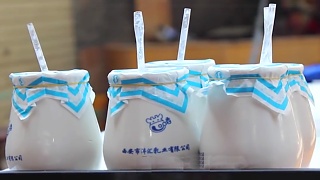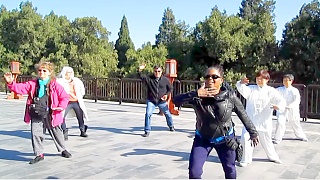Most associated with the Mid-Autumn Festival.
椒盐五仁月饼 Five-nut Mooncakes Expand Stop 五仁月饼和喝茶一样要慢慢地品。你从下面长长的食材列表里也可以看的出来,它的味道是极其丰富。各类的果仁,各样的糖浆,加上不同的果脯,都被浓缩在一个小小的月饼中。慢慢地吃,细细地品。体会每一种果仁味道,你才能真正感受到它给你带来的奢华。 椒盐五仁月饼材料: 10个中等大小的月饼 饼皮: 蜂蜜或者转化糖浆: 75克 油: 35克 3大勺 枧水: 10克 两小勺 盐:1克 1/8 小勺 低筋面粉:150克 一杯 馅料: 核桃仁:45克 花生仁:45克 黑白芝麻:共40克 松子:40克 南瓜籽:40克 葵花籽:40克 糖柑橘皮:30克 糖菠萝:60克 糯米粉:75克 玫瑰糖浆:40克 蜂蜜或者糖浆:30克 油:20克 两大勺少一点 香油:10克 一大勺 糖:25克 2大勺 盐:4克 1/2 小勺 花椒粉:2克 1 小勺 水:20-30克 1大勺到2大勺之间 蛋黄液: 蛋黄:一个 水:15克 一大勺 烤箱温度: 烤坚果温度和时间: 不需要预热烤箱。300°F /150°C 烤12-15分钟。具体时间的长短,要取决你烤箱预热的快慢。烤箱到达300°F /150°C之后大概烤3分钟。 烤月饼的温度和时间: 预热好的烤箱:400°F/205°C 烤五分钟 拿出来刷第一次蛋液。同时打开烤箱门散热 325°F/165°C 烤五分钟 拿出来刷第二次蛋液。 325°F/165°C 最后烤5-10钟至完全上色。 放凉后,放到密封的容器里回油2-3天。 Savory Five-nut mooncake ingredients: For making 10 medium size mooncakes Crust: Honey or invert sugar syrup: 75 g Oil: 35 g 3 tablespoons Lye water: 10 g 2 teaspoons salt: 1 g 1/8 teaspoon Cake flour: 150 g 1 cup Filling: Walnuts: 45 g Peanuts: 45 g Black and white sesames: 40 g Pine nuts: 40 g Pumpkin seeds: 40 g Sunflower seeds: 40 g Candied citrus peel: 30 g Candied pineapple: 60 g Glutinous rice flour: 75 g Sweeten rose sauce: 40 g Honey or invert sugar syrup: 30 g Oil: 20 g a little bit less than 2 tablespoon Sesame oil: 10 g 1 tablespoon Sugar: 25 g 2 tablespoons Salt: |
Chinese cuisine is an intricate tapestry of flavors, techniques, and regional specialties that has evolved over thousands of years. From the fiery spices of Sichuan to the delicate dim sum of Cantonese cuisine, every region of China offers its own culinary delights. For visitors to China, exploring the diverse and dynamic world of Chinese food is an essential part of experiencing the country's rich cultural heritage. Here's a more extensive exploration of Chinese cuisine for visitors:
Regional Diversity: Sichuan Cuisine : Hailing from the southwestern province of Sichuan, this cuisine is famed for its bold, spicy, and numbing flavors. Sichuan peppercorns, chili peppers, and aromatic spices are used liberally in dishes like Mapo Tofu, Dan Dan Noodles, and Sichuan Hot Pot, creating a symphony of flavors that tingles the taste buds.
Cantonese Cuisine : With its emphasis on fresh ingredients and delicate flavors, Cantonese cuisine is highly regarded for its seafood dishes, roasted meats, and dim sum. Steamed fish, Char Siu (barbecue pork), and Har Gow (shrimp dumplings) are just a few examples of the exquisite dishes that showcase Cantonese culinary mastery.
Shanghai Cuisine : Reflecting its coastal location and cosmopolitan history, Shanghai cuisine combines influences from Jiangsu, Zhejiang, and Anhui provinces. Sweet and Sour Mandarin Fish, Shanghai Soup Dumplings (Xiaolongbao), and Drunken Chicken are some of the signature dishes that highlight the diverse flavors and textures of this culinary tradition.
Beijing Cuisine : As the capital of China, Beijing boasts a rich culinary heritage deeply rooted in imperial traditions. Peking Duck, a dish with crispy skin and succulent meat served with pancakes and hoisin sauce, is a quintessential Beijing delicacy. Other notable dishes include Zhajiangmian (Beijing Noodles), Mongolian Hot Pot, and Beijing-style meat pies.
Hunan Cuisine : Known for its bold and aromatic flavors, Hunan cuisine features dishes that are spicy, sour, and intensely flavorful. Chairman Mao's Red-Braised Pork, Dong'an Chicken, and Steamed Fish Head with Chopped Chili exemplify the fiery and robust nature of Hunanese cooking, which makes ample use of chili peppers, garlic, and fermented ingredients.
Street Food and Snacks: Jianbing : This savory Chinese crepe is a popular breakfast option, consisting of a thin pancake filled with eggs, scallions, cilantro, and various fillings such as crispy fried dough, pickled vegetables, or chili sauce.
Baozi : These steamed buns are filled with a variety of savory or sweet fillings, including pork, vegetables, or red bean paste. Baozi are a popular street food snack and can be found in teahouses, markets, and street stalls across China.
Roujiamo : Often referred to as Chinese Hamburgers, roujiamo features savory braised meat stuffed inside a flatbread, offering a hearty and flavorful snack that's perfect for on-the-go eating.
Dining Etiquette and Customs: Family-Style Dining : Chinese meals are typically served family-style, with multiple dishes shared among diners seated around a table. It's customary to use chopsticks to pick up food from communal dishes and to serve elders before oneself.
Toasting and Ganbei : When dining with Chinese hosts, expect toasts (ganbei) with alcohol, usually baijiu (Chinese liquor). It's polite to reciprocate the toast and drink in moderation, but declining politely is acceptable if you don't drink alcohol.
Tea Culture : Tea is an integral part of Chinese dining culture, with a wide variety of teas available to complement different dishes. Green tea, oolong tea, and pu'er tea are among the most popular choices, and serving tea to guests is a sign of hospitality and respect.
Street Markets and Night Markets: Wangfujing Snack Street, Beijing : Located near the Forbidden City, this bustling street market offers a wide variety of traditional snacks, street food, and local delicacies. Visitors can sample everything from scorpions on a stick to traditional Beijing snacks like Jianbing and Tanghulu (candied fruit skewers).
Shanghai Old Street, Shanghai : Nestled in the heart of the city's historic district, Shanghai Old Street is a bustling marketplace where visitors can explore narrow alleyways lined with traditional shops, street vendors, and food stalls. From steamed dumplings and stinky tofu to hand-pulled noodles and sugar-coated haws, there's something to satisfy every craving.
Dietary Considerations: Vegetarian and Vegan Options : While Chinese cuisine traditionally features a wide range of meats and animal products, vegetarian and vegan options are becoming increasingly available, especially in larger cities and tourist destinations. Buddhist restaurants (????, s�sh� c?nt?ng) often offer meat-free versions of classic dishes, and plant-based ingredients like tofu, mushrooms, and seasonal vegetables are widely used in Chinese cooking.
Exploring the diverse and delicious world of Chinese cuisine is an essential part of any visit to China. From regional specialties and street food snacks to dining etiquette and cultural customs, the culinary landscape of China offers a rich tapestry of flavors, traditions, and experiences that are sure to delight and inspire visitors from around the world. Bon app�tit!.
 Perfect Five-Nut MoonCakes
Perfect Five-Nut MoonCakes



















